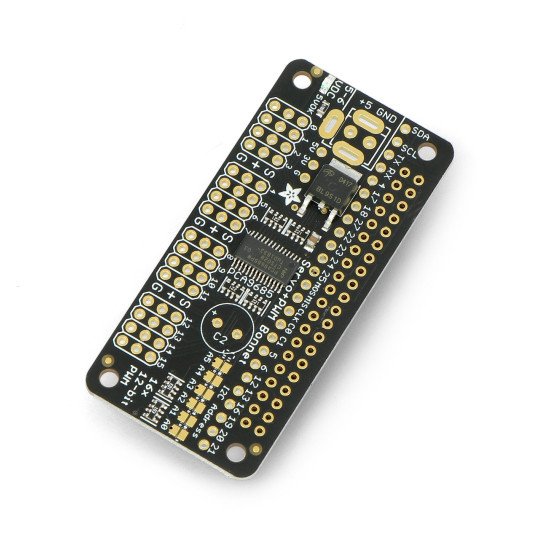Product description: Servo Bonnet - 16 channel I2C PWM controller for Raspberry Pi - Adafruit 3416
TheRaspberry Pi is a very useful minicomputer, however generating a precise PWM signal to control servos through the Linux kernel doesn't work very well for it. The Servo Bonnet overlay allows you to control 16 servos. The chip generates PWM signals up to 1.6 kHz with 12-bit precision, communicates over the I2C interface using only two Raspberry Pi pins. The overlays can be connected together up to 62 pieces which allows to control a total of 992 servos.
The overlay allows control of servos supplied with 5V and operating at a logic voltage of 3.3V.
In order to increase the output logic voltage from 3.3 V to 5 V solder the jumper on the board.
Specification
- Number of PWM channels: 16
- Resolution: 12 bits
- Maximum frequency: 1.6 kHz
- Communication: I2C (SCL, SDA)
- Separate power connector: 5 V to 6 V
- Works with Raspberry Pi with 2 x 20 pins
- Board dimensions: 65 mm x 30.4 mm x 8 mm
16 channel PWM controller for Raspberry Pi
The Servo Bonnet overlay is a universal PWM controller, providing the user with 16 PWM channels. Their settings can be easily changed using commands sent over the I2C bus. Input logic levels of the controller are adjusted to the requirements of the Raspberry ports (0..3,3V), while the output PWM signals have an amplitude of 5 V.
Servo Bonnet - 16-channel I2C PWM controller for Raspberry Pi - Adafruit 3416 generates control signals up to 1600 Hz with 12-bit resolution. This means that the fill factor can be set in 1/40% steps, which is enough to control even the most precise servos.
Applications of Adafruit 3416 PWM controller
The Servo Bonnet overlay greatly enhances the capabilities of the Raspberry Pi to control complex structures - including walking robots or robotic manipulators based on modeling servos. The controller significantly offloads the processor of the minicomputer, relieving it of the need to generate pulses in real time.
What's more, the Adafruit 3416 PWM controller allows you to set the I2C address (using jumpers on the PCB), so with just two GPIO lines of the minicomputer you can control up to several dozen overlays simultaneously. This gives wide possibilities of building LED matrices, spectral displays or other, multi-channel lighting effects.
Useful links |































































































































































































































































































































































